Management Operations Report: Leadership, Management, and Strategy
VerifiedAdded on 2021/02/19
|11
|4616
|76
Report
AI Summary
This report delves into the realm of management operations, examining the roles and characteristics of leaders and managers, and comparing their functions in diverse situations. It explores the application of various leadership theories, including contemporary, behavioral, situational, system, and contingency leadership, within the context of companies like Thomas Cook and Tesco. The report further analyzes different approaches to operations management, such as Six Sigma and Total Quality Management (TQM), highlighting their importance and value in achieving business objectives. It assesses external factors influencing operational decision-making and provides a comprehensive overview of strategic approaches to enhance operational efficiency, quality, and overall organizational success. The report also considers the impact of these strategies on cost management and the role of leaders and managers in implementing these changes.
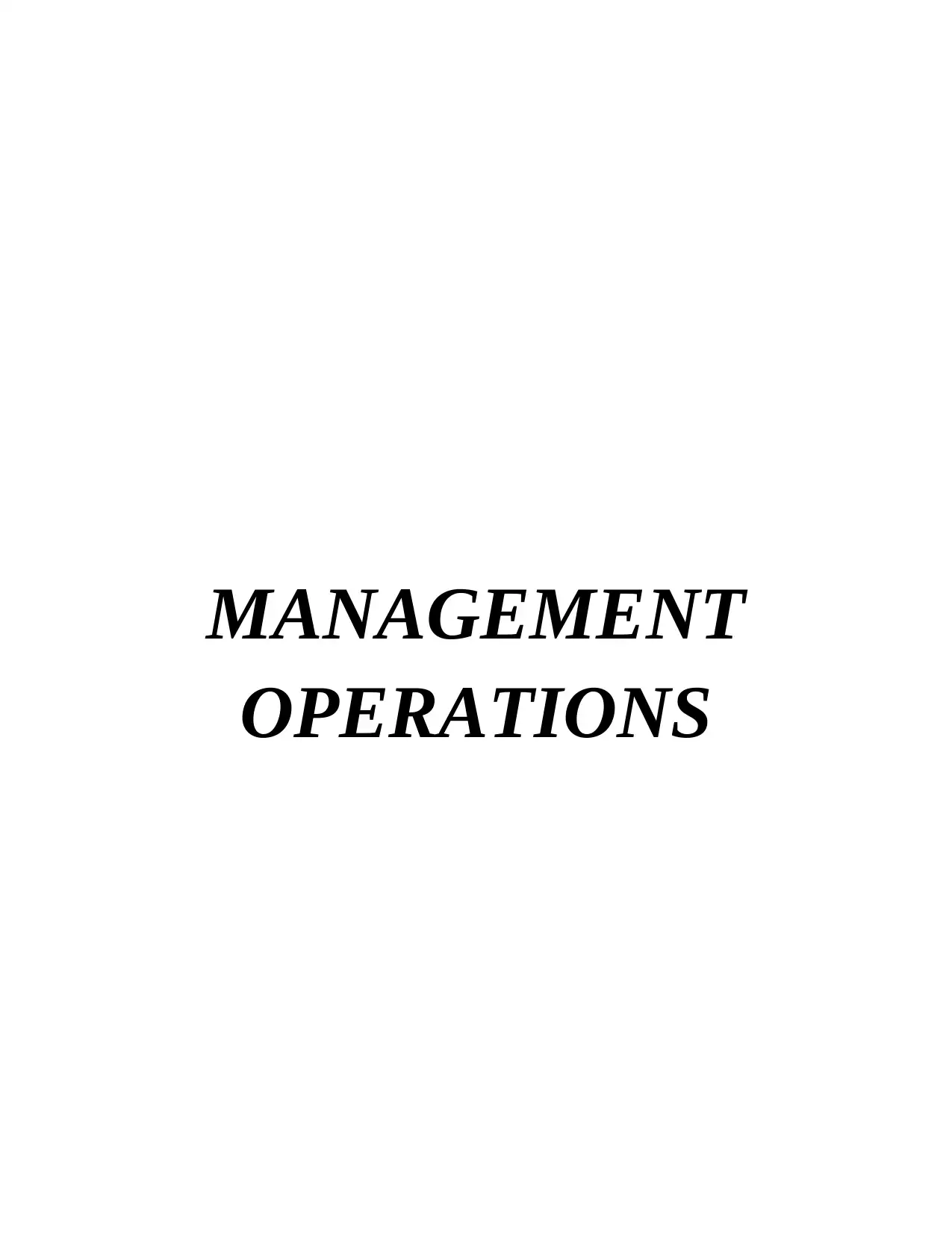
MANAGEMENT
OPERATIONS
OPERATIONS
Paraphrase This Document
Need a fresh take? Get an instant paraphrase of this document with our AI Paraphraser
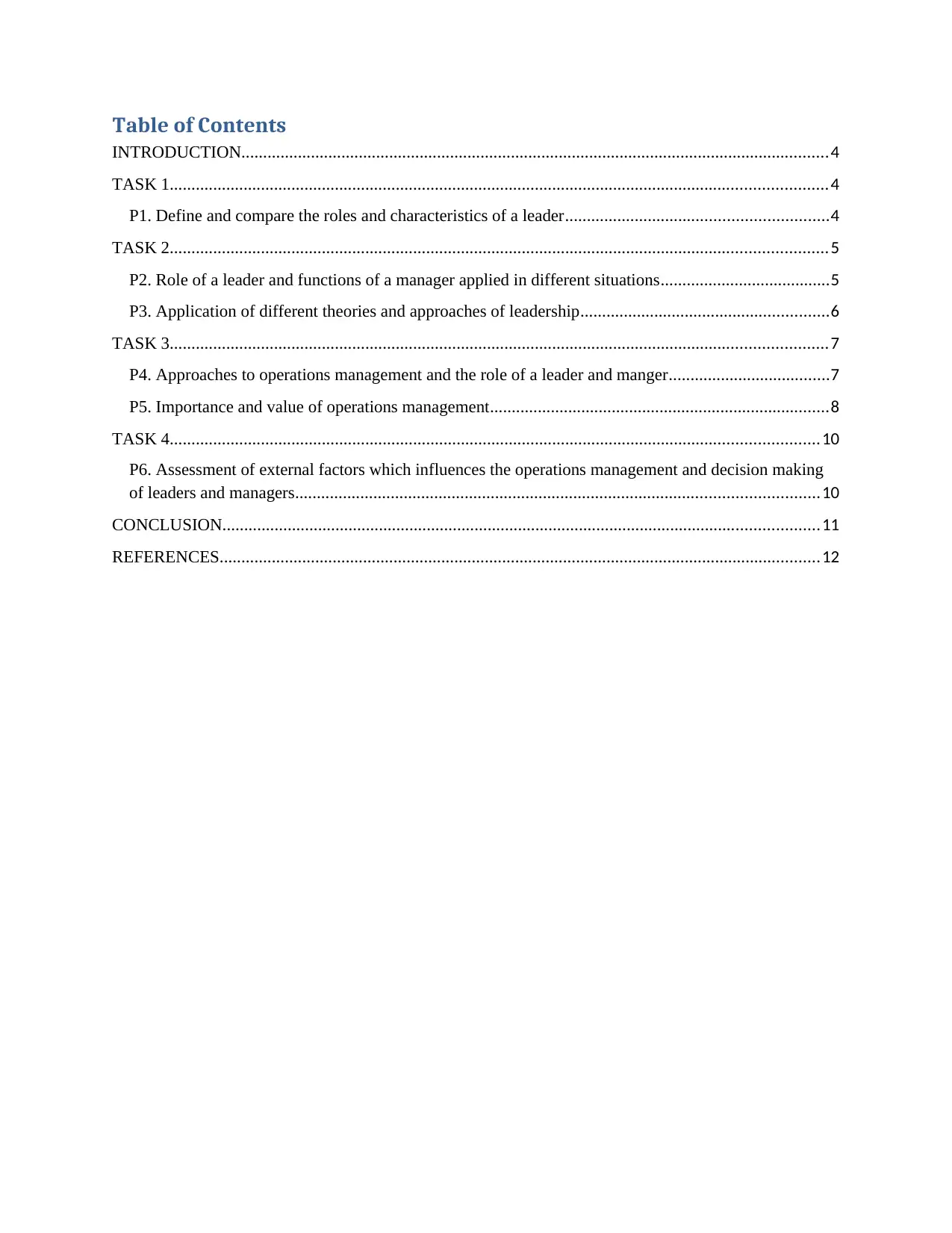
Table of Contents
INTRODUCTION.......................................................................................................................................4
TASK 1.......................................................................................................................................................4
P1. Define and compare the roles and characteristics of a leader............................................................4
TASK 2.......................................................................................................................................................5
P2. Role of a leader and functions of a manager applied in different situations.......................................5
P3. Application of different theories and approaches of leadership.........................................................6
TASK 3.......................................................................................................................................................7
P4. Approaches to operations management and the role of a leader and manger.....................................7
P5. Importance and value of operations management..............................................................................8
TASK 4.....................................................................................................................................................10
P6. Assessment of external factors which influences the operations management and decision making
of leaders and managers........................................................................................................................10
CONCLUSION.........................................................................................................................................11
REFERENCES..........................................................................................................................................12
INTRODUCTION.......................................................................................................................................4
TASK 1.......................................................................................................................................................4
P1. Define and compare the roles and characteristics of a leader............................................................4
TASK 2.......................................................................................................................................................5
P2. Role of a leader and functions of a manager applied in different situations.......................................5
P3. Application of different theories and approaches of leadership.........................................................6
TASK 3.......................................................................................................................................................7
P4. Approaches to operations management and the role of a leader and manger.....................................7
P5. Importance and value of operations management..............................................................................8
TASK 4.....................................................................................................................................................10
P6. Assessment of external factors which influences the operations management and decision making
of leaders and managers........................................................................................................................10
CONCLUSION.........................................................................................................................................11
REFERENCES..........................................................................................................................................12
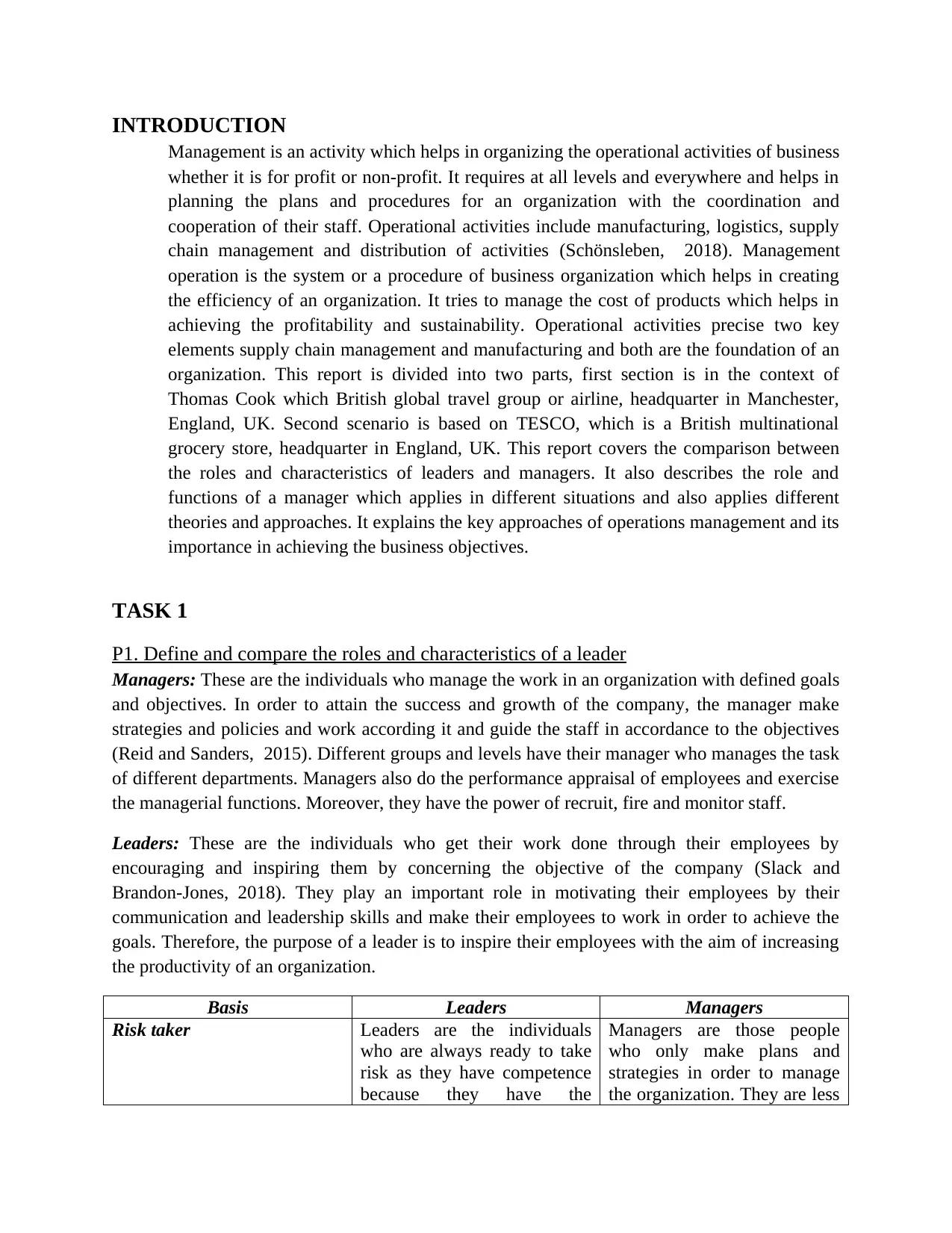
INTRODUCTION
Management is an activity which helps in organizing the operational activities of business
whether it is for profit or non-profit. It requires at all levels and everywhere and helps in
planning the plans and procedures for an organization with the coordination and
cooperation of their staff. Operational activities include manufacturing, logistics, supply
chain management and distribution of activities (Schönsleben, 2018). Management
operation is the system or a procedure of business organization which helps in creating
the efficiency of an organization. It tries to manage the cost of products which helps in
achieving the profitability and sustainability. Operational activities precise two key
elements supply chain management and manufacturing and both are the foundation of an
organization. This report is divided into two parts, first section is in the context of
Thomas Cook which British global travel group or airline, headquarter in Manchester,
England, UK. Second scenario is based on TESCO, which is a British multinational
grocery store, headquarter in England, UK. This report covers the comparison between
the roles and characteristics of leaders and managers. It also describes the role and
functions of a manager which applies in different situations and also applies different
theories and approaches. It explains the key approaches of operations management and its
importance in achieving the business objectives.
TASK 1
P1. Define and compare the roles and characteristics of a leader
Managers: These are the individuals who manage the work in an organization with defined goals
and objectives. In order to attain the success and growth of the company, the manager make
strategies and policies and work according it and guide the staff in accordance to the objectives
(Reid and Sanders, 2015). Different groups and levels have their manager who manages the task
of different departments. Managers also do the performance appraisal of employees and exercise
the managerial functions. Moreover, they have the power of recruit, fire and monitor staff.
Leaders: These are the individuals who get their work done through their employees by
encouraging and inspiring them by concerning the objective of the company (Slack and
Brandon-Jones, 2018). They play an important role in motivating their employees by their
communication and leadership skills and make their employees to work in order to achieve the
goals. Therefore, the purpose of a leader is to inspire their employees with the aim of increasing
the productivity of an organization.
Basis Leaders Managers
Risk taker Leaders are the individuals
who are always ready to take
risk as they have competence
because they have the
Managers are those people
who only make plans and
strategies in order to manage
the organization. They are less
Management is an activity which helps in organizing the operational activities of business
whether it is for profit or non-profit. It requires at all levels and everywhere and helps in
planning the plans and procedures for an organization with the coordination and
cooperation of their staff. Operational activities include manufacturing, logistics, supply
chain management and distribution of activities (Schönsleben, 2018). Management
operation is the system or a procedure of business organization which helps in creating
the efficiency of an organization. It tries to manage the cost of products which helps in
achieving the profitability and sustainability. Operational activities precise two key
elements supply chain management and manufacturing and both are the foundation of an
organization. This report is divided into two parts, first section is in the context of
Thomas Cook which British global travel group or airline, headquarter in Manchester,
England, UK. Second scenario is based on TESCO, which is a British multinational
grocery store, headquarter in England, UK. This report covers the comparison between
the roles and characteristics of leaders and managers. It also describes the role and
functions of a manager which applies in different situations and also applies different
theories and approaches. It explains the key approaches of operations management and its
importance in achieving the business objectives.
TASK 1
P1. Define and compare the roles and characteristics of a leader
Managers: These are the individuals who manage the work in an organization with defined goals
and objectives. In order to attain the success and growth of the company, the manager make
strategies and policies and work according it and guide the staff in accordance to the objectives
(Reid and Sanders, 2015). Different groups and levels have their manager who manages the task
of different departments. Managers also do the performance appraisal of employees and exercise
the managerial functions. Moreover, they have the power of recruit, fire and monitor staff.
Leaders: These are the individuals who get their work done through their employees by
encouraging and inspiring them by concerning the objective of the company (Slack and
Brandon-Jones, 2018). They play an important role in motivating their employees by their
communication and leadership skills and make their employees to work in order to achieve the
goals. Therefore, the purpose of a leader is to inspire their employees with the aim of increasing
the productivity of an organization.
Basis Leaders Managers
Risk taker Leaders are the individuals
who are always ready to take
risk as they have competence
because they have the
Managers are those people
who only make plans and
strategies in order to manage
the organization. They are less
⊘ This is a preview!⊘
Do you want full access?
Subscribe today to unlock all pages.

Trusted by 1+ million students worldwide
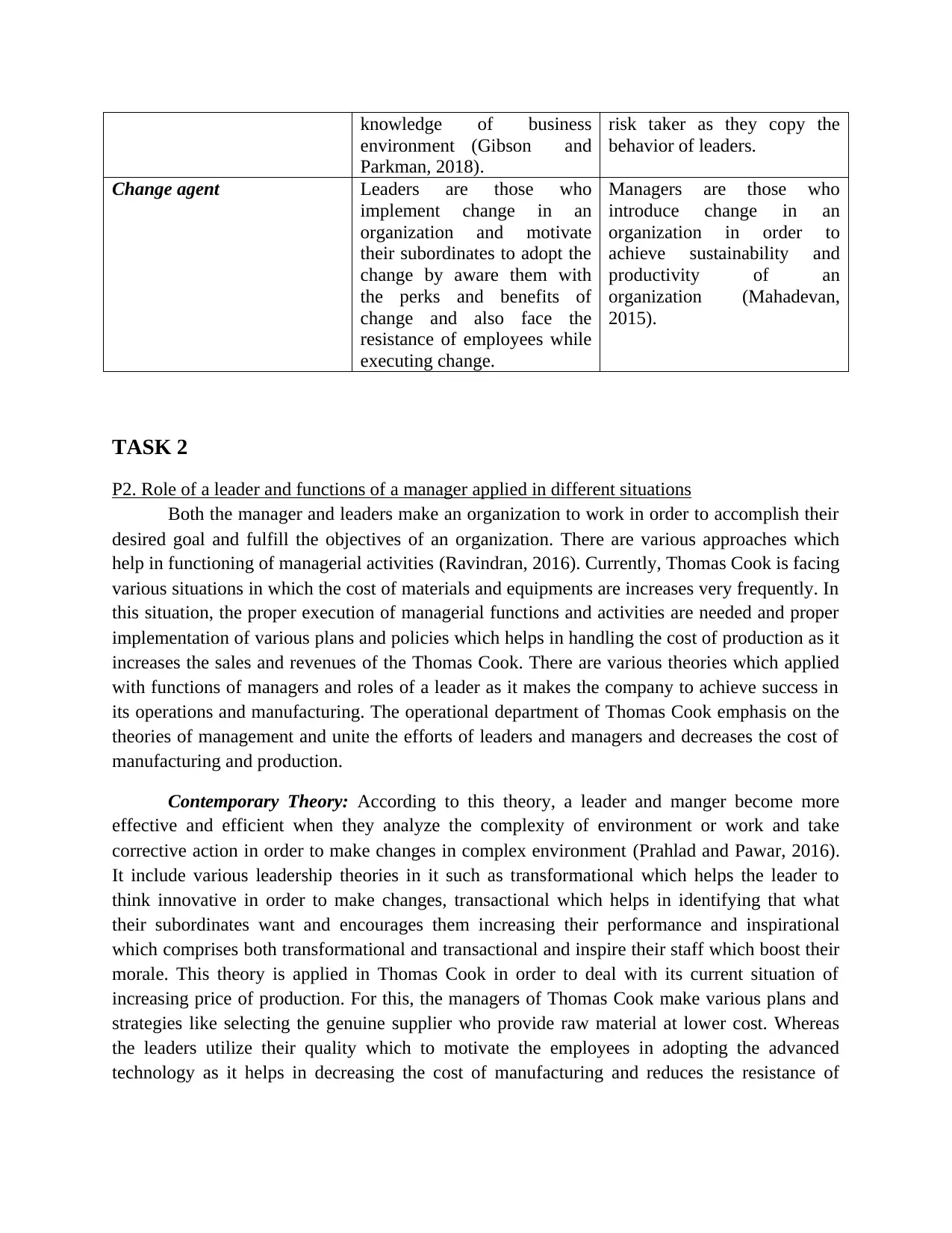
knowledge of business
environment (Gibson and
Parkman, 2018).
risk taker as they copy the
behavior of leaders.
Change agent Leaders are those who
implement change in an
organization and motivate
their subordinates to adopt the
change by aware them with
the perks and benefits of
change and also face the
resistance of employees while
executing change.
Managers are those who
introduce change in an
organization in order to
achieve sustainability and
productivity of an
organization (Mahadevan,
2015).
TASK 2
P2. Role of a leader and functions of a manager applied in different situations
Both the manager and leaders make an organization to work in order to accomplish their
desired goal and fulfill the objectives of an organization. There are various approaches which
help in functioning of managerial activities (Ravindran, 2016). Currently, Thomas Cook is facing
various situations in which the cost of materials and equipments are increases very frequently. In
this situation, the proper execution of managerial functions and activities are needed and proper
implementation of various plans and policies which helps in handling the cost of production as it
increases the sales and revenues of the Thomas Cook. There are various theories which applied
with functions of managers and roles of a leader as it makes the company to achieve success in
its operations and manufacturing. The operational department of Thomas Cook emphasis on the
theories of management and unite the efforts of leaders and managers and decreases the cost of
manufacturing and production.
Contemporary Theory: According to this theory, a leader and manger become more
effective and efficient when they analyze the complexity of environment or work and take
corrective action in order to make changes in complex environment (Prahlad and Pawar, 2016).
It include various leadership theories in it such as transformational which helps the leader to
think innovative in order to make changes, transactional which helps in identifying that what
their subordinates want and encourages them increasing their performance and inspirational
which comprises both transformational and transactional and inspire their staff which boost their
morale. This theory is applied in Thomas Cook in order to deal with its current situation of
increasing price of production. For this, the managers of Thomas Cook make various plans and
strategies like selecting the genuine supplier who provide raw material at lower cost. Whereas
the leaders utilize their quality which to motivate the employees in adopting the advanced
technology as it helps in decreasing the cost of manufacturing and reduces the resistance of
environment (Gibson and
Parkman, 2018).
risk taker as they copy the
behavior of leaders.
Change agent Leaders are those who
implement change in an
organization and motivate
their subordinates to adopt the
change by aware them with
the perks and benefits of
change and also face the
resistance of employees while
executing change.
Managers are those who
introduce change in an
organization in order to
achieve sustainability and
productivity of an
organization (Mahadevan,
2015).
TASK 2
P2. Role of a leader and functions of a manager applied in different situations
Both the manager and leaders make an organization to work in order to accomplish their
desired goal and fulfill the objectives of an organization. There are various approaches which
help in functioning of managerial activities (Ravindran, 2016). Currently, Thomas Cook is facing
various situations in which the cost of materials and equipments are increases very frequently. In
this situation, the proper execution of managerial functions and activities are needed and proper
implementation of various plans and policies which helps in handling the cost of production as it
increases the sales and revenues of the Thomas Cook. There are various theories which applied
with functions of managers and roles of a leader as it makes the company to achieve success in
its operations and manufacturing. The operational department of Thomas Cook emphasis on the
theories of management and unite the efforts of leaders and managers and decreases the cost of
manufacturing and production.
Contemporary Theory: According to this theory, a leader and manger become more
effective and efficient when they analyze the complexity of environment or work and take
corrective action in order to make changes in complex environment (Prahlad and Pawar, 2016).
It include various leadership theories in it such as transformational which helps the leader to
think innovative in order to make changes, transactional which helps in identifying that what
their subordinates want and encourages them increasing their performance and inspirational
which comprises both transformational and transactional and inspire their staff which boost their
morale. This theory is applied in Thomas Cook in order to deal with its current situation of
increasing price of production. For this, the managers of Thomas Cook make various plans and
strategies like selecting the genuine supplier who provide raw material at lower cost. Whereas
the leaders utilize their quality which to motivate the employees in adopting the advanced
technology as it helps in decreasing the cost of manufacturing and reduces the resistance of
Paraphrase This Document
Need a fresh take? Get an instant paraphrase of this document with our AI Paraphraser
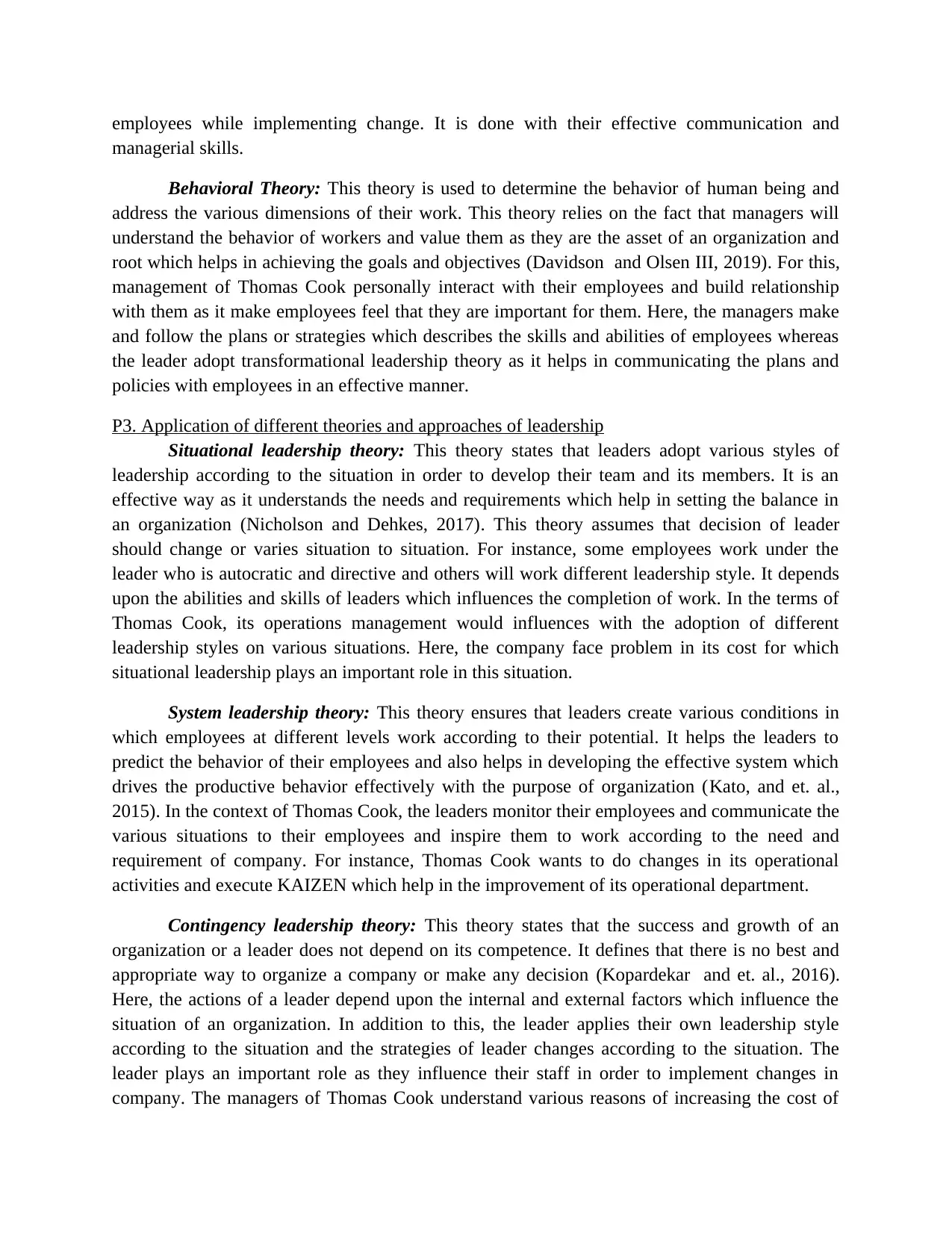
employees while implementing change. It is done with their effective communication and
managerial skills.
Behavioral Theory: This theory is used to determine the behavior of human being and
address the various dimensions of their work. This theory relies on the fact that managers will
understand the behavior of workers and value them as they are the asset of an organization and
root which helps in achieving the goals and objectives (Davidson and Olsen III, 2019). For this,
management of Thomas Cook personally interact with their employees and build relationship
with them as it make employees feel that they are important for them. Here, the managers make
and follow the plans or strategies which describes the skills and abilities of employees whereas
the leader adopt transformational leadership theory as it helps in communicating the plans and
policies with employees in an effective manner.
P3. Application of different theories and approaches of leadership
Situational leadership theory: This theory states that leaders adopt various styles of
leadership according to the situation in order to develop their team and its members. It is an
effective way as it understands the needs and requirements which help in setting the balance in
an organization (Nicholson and Dehkes, 2017). This theory assumes that decision of leader
should change or varies situation to situation. For instance, some employees work under the
leader who is autocratic and directive and others will work different leadership style. It depends
upon the abilities and skills of leaders which influences the completion of work. In the terms of
Thomas Cook, its operations management would influences with the adoption of different
leadership styles on various situations. Here, the company face problem in its cost for which
situational leadership plays an important role in this situation.
System leadership theory: This theory ensures that leaders create various conditions in
which employees at different levels work according to their potential. It helps the leaders to
predict the behavior of their employees and also helps in developing the effective system which
drives the productive behavior effectively with the purpose of organization (Kato, and et. al.,
2015). In the context of Thomas Cook, the leaders monitor their employees and communicate the
various situations to their employees and inspire them to work according to the need and
requirement of company. For instance, Thomas Cook wants to do changes in its operational
activities and execute KAIZEN which help in the improvement of its operational department.
Contingency leadership theory: This theory states that the success and growth of an
organization or a leader does not depend on its competence. It defines that there is no best and
appropriate way to organize a company or make any decision (Kopardekar and et. al., 2016).
Here, the actions of a leader depend upon the internal and external factors which influence the
situation of an organization. In addition to this, the leader applies their own leadership style
according to the situation and the strategies of leader changes according to the situation. The
leader plays an important role as they influence their staff in order to implement changes in
company. The managers of Thomas Cook understand various reasons of increasing the cost of
managerial skills.
Behavioral Theory: This theory is used to determine the behavior of human being and
address the various dimensions of their work. This theory relies on the fact that managers will
understand the behavior of workers and value them as they are the asset of an organization and
root which helps in achieving the goals and objectives (Davidson and Olsen III, 2019). For this,
management of Thomas Cook personally interact with their employees and build relationship
with them as it make employees feel that they are important for them. Here, the managers make
and follow the plans or strategies which describes the skills and abilities of employees whereas
the leader adopt transformational leadership theory as it helps in communicating the plans and
policies with employees in an effective manner.
P3. Application of different theories and approaches of leadership
Situational leadership theory: This theory states that leaders adopt various styles of
leadership according to the situation in order to develop their team and its members. It is an
effective way as it understands the needs and requirements which help in setting the balance in
an organization (Nicholson and Dehkes, 2017). This theory assumes that decision of leader
should change or varies situation to situation. For instance, some employees work under the
leader who is autocratic and directive and others will work different leadership style. It depends
upon the abilities and skills of leaders which influences the completion of work. In the terms of
Thomas Cook, its operations management would influences with the adoption of different
leadership styles on various situations. Here, the company face problem in its cost for which
situational leadership plays an important role in this situation.
System leadership theory: This theory ensures that leaders create various conditions in
which employees at different levels work according to their potential. It helps the leaders to
predict the behavior of their employees and also helps in developing the effective system which
drives the productive behavior effectively with the purpose of organization (Kato, and et. al.,
2015). In the context of Thomas Cook, the leaders monitor their employees and communicate the
various situations to their employees and inspire them to work according to the need and
requirement of company. For instance, Thomas Cook wants to do changes in its operational
activities and execute KAIZEN which help in the improvement of its operational department.
Contingency leadership theory: This theory states that the success and growth of an
organization or a leader does not depend on its competence. It defines that there is no best and
appropriate way to organize a company or make any decision (Kopardekar and et. al., 2016).
Here, the actions of a leader depend upon the internal and external factors which influence the
situation of an organization. In addition to this, the leader applies their own leadership style
according to the situation and the strategies of leader changes according to the situation. The
leader plays an important role as they influence their staff in order to implement changes in
company. The managers of Thomas Cook understand various reasons of increasing the cost of
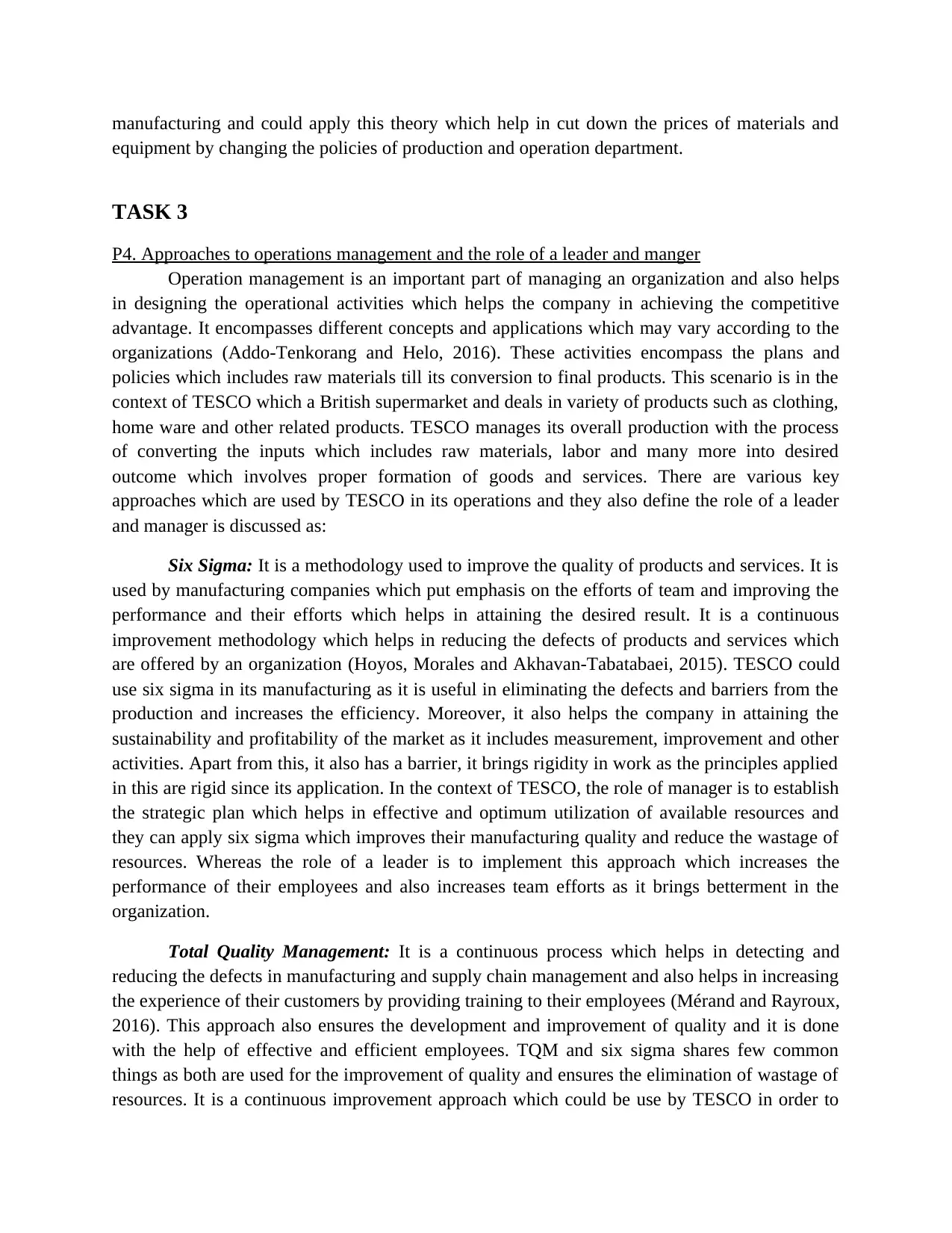
manufacturing and could apply this theory which help in cut down the prices of materials and
equipment by changing the policies of production and operation department.
TASK 3
P4. Approaches to operations management and the role of a leader and manger
Operation management is an important part of managing an organization and also helps
in designing the operational activities which helps the company in achieving the competitive
advantage. It encompasses different concepts and applications which may vary according to the
organizations (Addo-Tenkorang and Helo, 2016). These activities encompass the plans and
policies which includes raw materials till its conversion to final products. This scenario is in the
context of TESCO which a British supermarket and deals in variety of products such as clothing,
home ware and other related products. TESCO manages its overall production with the process
of converting the inputs which includes raw materials, labor and many more into desired
outcome which involves proper formation of goods and services. There are various key
approaches which are used by TESCO in its operations and they also define the role of a leader
and manager is discussed as:
Six Sigma: It is a methodology used to improve the quality of products and services. It is
used by manufacturing companies which put emphasis on the efforts of team and improving the
performance and their efforts which helps in attaining the desired result. It is a continuous
improvement methodology which helps in reducing the defects of products and services which
are offered by an organization (Hoyos, Morales and Akhavan-Tabatabaei, 2015). TESCO could
use six sigma in its manufacturing as it is useful in eliminating the defects and barriers from the
production and increases the efficiency. Moreover, it also helps the company in attaining the
sustainability and profitability of the market as it includes measurement, improvement and other
activities. Apart from this, it also has a barrier, it brings rigidity in work as the principles applied
in this are rigid since its application. In the context of TESCO, the role of manager is to establish
the strategic plan which helps in effective and optimum utilization of available resources and
they can apply six sigma which improves their manufacturing quality and reduce the wastage of
resources. Whereas the role of a leader is to implement this approach which increases the
performance of their employees and also increases team efforts as it brings betterment in the
organization.
Total Quality Management: It is a continuous process which helps in detecting and
reducing the defects in manufacturing and supply chain management and also helps in increasing
the experience of their customers by providing training to their employees (Mérand and Rayroux,
2016). This approach also ensures the development and improvement of quality and it is done
with the help of effective and efficient employees. TQM and six sigma shares few common
things as both are used for the improvement of quality and ensures the elimination of wastage of
resources. It is a continuous improvement approach which could be use by TESCO in order to
equipment by changing the policies of production and operation department.
TASK 3
P4. Approaches to operations management and the role of a leader and manger
Operation management is an important part of managing an organization and also helps
in designing the operational activities which helps the company in achieving the competitive
advantage. It encompasses different concepts and applications which may vary according to the
organizations (Addo-Tenkorang and Helo, 2016). These activities encompass the plans and
policies which includes raw materials till its conversion to final products. This scenario is in the
context of TESCO which a British supermarket and deals in variety of products such as clothing,
home ware and other related products. TESCO manages its overall production with the process
of converting the inputs which includes raw materials, labor and many more into desired
outcome which involves proper formation of goods and services. There are various key
approaches which are used by TESCO in its operations and they also define the role of a leader
and manager is discussed as:
Six Sigma: It is a methodology used to improve the quality of products and services. It is
used by manufacturing companies which put emphasis on the efforts of team and improving the
performance and their efforts which helps in attaining the desired result. It is a continuous
improvement methodology which helps in reducing the defects of products and services which
are offered by an organization (Hoyos, Morales and Akhavan-Tabatabaei, 2015). TESCO could
use six sigma in its manufacturing as it is useful in eliminating the defects and barriers from the
production and increases the efficiency. Moreover, it also helps the company in attaining the
sustainability and profitability of the market as it includes measurement, improvement and other
activities. Apart from this, it also has a barrier, it brings rigidity in work as the principles applied
in this are rigid since its application. In the context of TESCO, the role of manager is to establish
the strategic plan which helps in effective and optimum utilization of available resources and
they can apply six sigma which improves their manufacturing quality and reduce the wastage of
resources. Whereas the role of a leader is to implement this approach which increases the
performance of their employees and also increases team efforts as it brings betterment in the
organization.
Total Quality Management: It is a continuous process which helps in detecting and
reducing the defects in manufacturing and supply chain management and also helps in increasing
the experience of their customers by providing training to their employees (Mérand and Rayroux,
2016). This approach also ensures the development and improvement of quality and it is done
with the help of effective and efficient employees. TQM and six sigma shares few common
things as both are used for the improvement of quality and ensures the elimination of wastage of
resources. It is a continuous improvement approach which could be use by TESCO in order to
⊘ This is a preview!⊘
Do you want full access?
Subscribe today to unlock all pages.

Trusted by 1+ million students worldwide
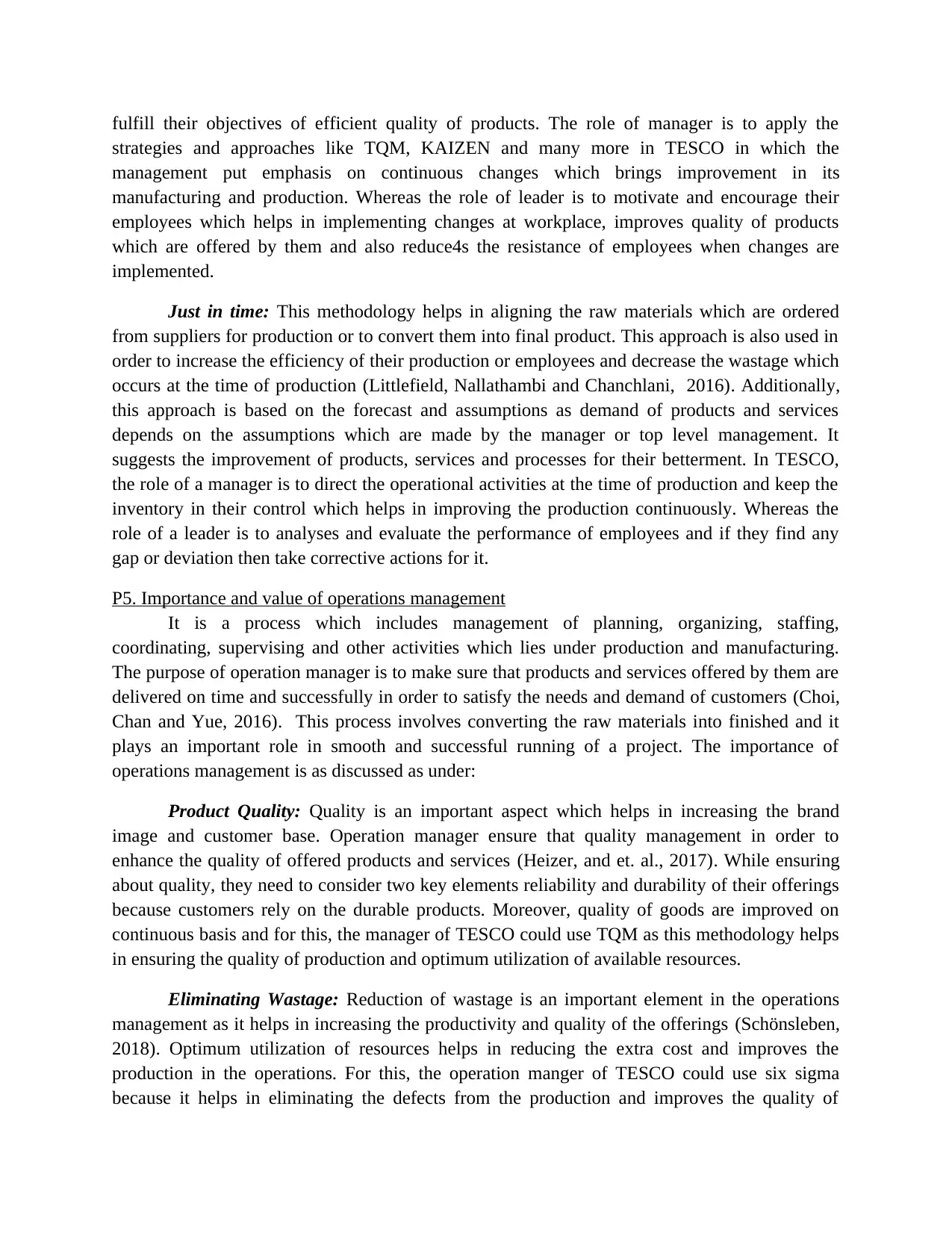
fulfill their objectives of efficient quality of products. The role of manager is to apply the
strategies and approaches like TQM, KAIZEN and many more in TESCO in which the
management put emphasis on continuous changes which brings improvement in its
manufacturing and production. Whereas the role of leader is to motivate and encourage their
employees which helps in implementing changes at workplace, improves quality of products
which are offered by them and also reduce4s the resistance of employees when changes are
implemented.
Just in time: This methodology helps in aligning the raw materials which are ordered
from suppliers for production or to convert them into final product. This approach is also used in
order to increase the efficiency of their production or employees and decrease the wastage which
occurs at the time of production (Littlefield, Nallathambi and Chanchlani, 2016). Additionally,
this approach is based on the forecast and assumptions as demand of products and services
depends on the assumptions which are made by the manager or top level management. It
suggests the improvement of products, services and processes for their betterment. In TESCO,
the role of a manager is to direct the operational activities at the time of production and keep the
inventory in their control which helps in improving the production continuously. Whereas the
role of a leader is to analyses and evaluate the performance of employees and if they find any
gap or deviation then take corrective actions for it.
P5. Importance and value of operations management
It is a process which includes management of planning, organizing, staffing,
coordinating, supervising and other activities which lies under production and manufacturing.
The purpose of operation manager is to make sure that products and services offered by them are
delivered on time and successfully in order to satisfy the needs and demand of customers (Choi,
Chan and Yue, 2016). This process involves converting the raw materials into finished and it
plays an important role in smooth and successful running of a project. The importance of
operations management is as discussed as under:
Product Quality: Quality is an important aspect which helps in increasing the brand
image and customer base. Operation manager ensure that quality management in order to
enhance the quality of offered products and services (Heizer, and et. al., 2017). While ensuring
about quality, they need to consider two key elements reliability and durability of their offerings
because customers rely on the durable products. Moreover, quality of goods are improved on
continuous basis and for this, the manager of TESCO could use TQM as this methodology helps
in ensuring the quality of production and optimum utilization of available resources.
Eliminating Wastage: Reduction of wastage is an important element in the operations
management as it helps in increasing the productivity and quality of the offerings (Schönsleben,
2018). Optimum utilization of resources helps in reducing the extra cost and improves the
production in the operations. For this, the operation manger of TESCO could use six sigma
because it helps in eliminating the defects from the production and improves the quality of
strategies and approaches like TQM, KAIZEN and many more in TESCO in which the
management put emphasis on continuous changes which brings improvement in its
manufacturing and production. Whereas the role of leader is to motivate and encourage their
employees which helps in implementing changes at workplace, improves quality of products
which are offered by them and also reduce4s the resistance of employees when changes are
implemented.
Just in time: This methodology helps in aligning the raw materials which are ordered
from suppliers for production or to convert them into final product. This approach is also used in
order to increase the efficiency of their production or employees and decrease the wastage which
occurs at the time of production (Littlefield, Nallathambi and Chanchlani, 2016). Additionally,
this approach is based on the forecast and assumptions as demand of products and services
depends on the assumptions which are made by the manager or top level management. It
suggests the improvement of products, services and processes for their betterment. In TESCO,
the role of a manager is to direct the operational activities at the time of production and keep the
inventory in their control which helps in improving the production continuously. Whereas the
role of a leader is to analyses and evaluate the performance of employees and if they find any
gap or deviation then take corrective actions for it.
P5. Importance and value of operations management
It is a process which includes management of planning, organizing, staffing,
coordinating, supervising and other activities which lies under production and manufacturing.
The purpose of operation manager is to make sure that products and services offered by them are
delivered on time and successfully in order to satisfy the needs and demand of customers (Choi,
Chan and Yue, 2016). This process involves converting the raw materials into finished and it
plays an important role in smooth and successful running of a project. The importance of
operations management is as discussed as under:
Product Quality: Quality is an important aspect which helps in increasing the brand
image and customer base. Operation manager ensure that quality management in order to
enhance the quality of offered products and services (Heizer, and et. al., 2017). While ensuring
about quality, they need to consider two key elements reliability and durability of their offerings
because customers rely on the durable products. Moreover, quality of goods are improved on
continuous basis and for this, the manager of TESCO could use TQM as this methodology helps
in ensuring the quality of production and optimum utilization of available resources.
Eliminating Wastage: Reduction of wastage is an important element in the operations
management as it helps in increasing the productivity and quality of the offerings (Schönsleben,
2018). Optimum utilization of resources helps in reducing the extra cost and improves the
production in the operations. For this, the operation manger of TESCO could use six sigma
because it helps in eliminating the defects from the production and improves the quality of
Paraphrase This Document
Need a fresh take? Get an instant paraphrase of this document with our AI Paraphraser
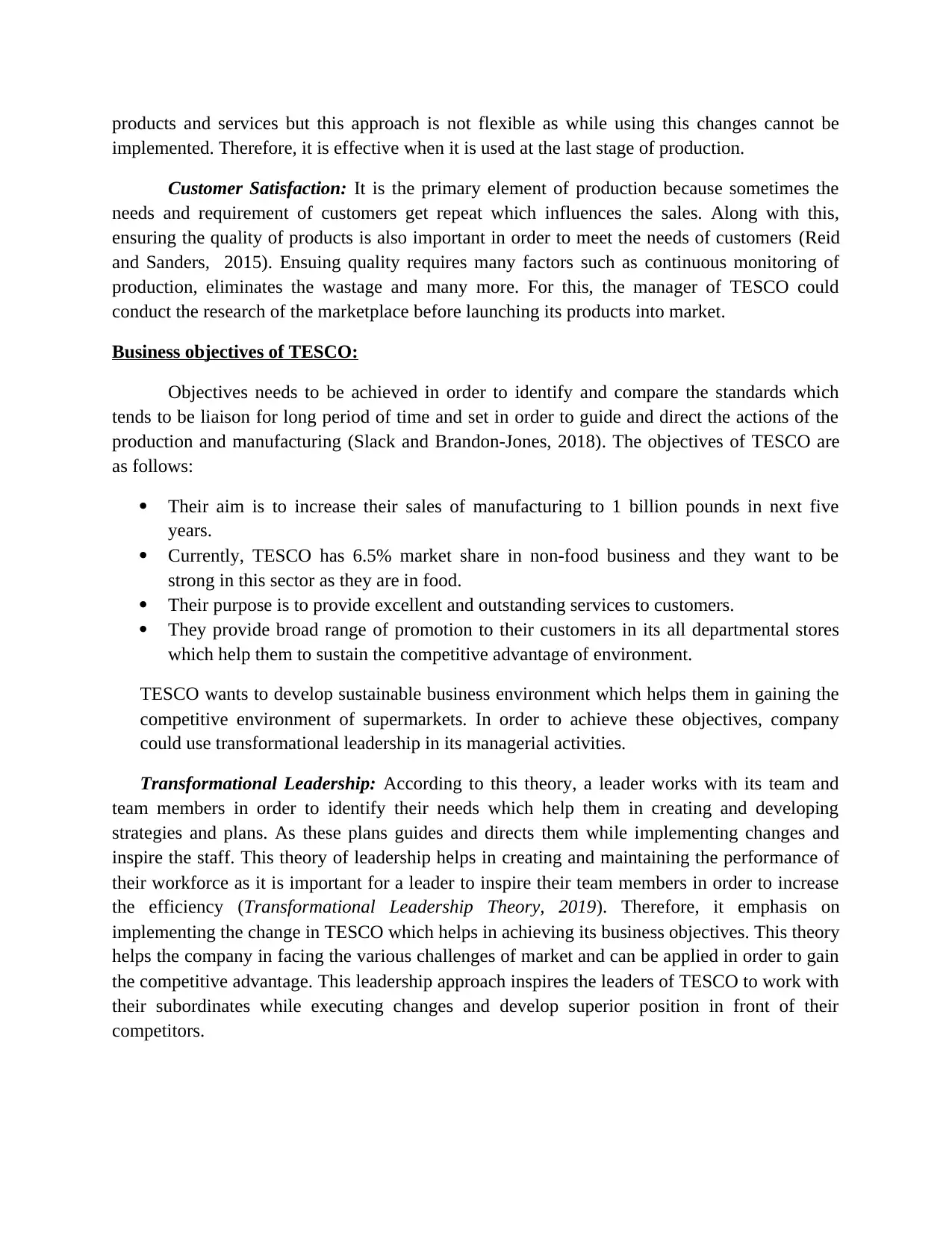
products and services but this approach is not flexible as while using this changes cannot be
implemented. Therefore, it is effective when it is used at the last stage of production.
Customer Satisfaction: It is the primary element of production because sometimes the
needs and requirement of customers get repeat which influences the sales. Along with this,
ensuring the quality of products is also important in order to meet the needs of customers (Reid
and Sanders, 2015). Ensuing quality requires many factors such as continuous monitoring of
production, eliminates the wastage and many more. For this, the manager of TESCO could
conduct the research of the marketplace before launching its products into market.
Business objectives of TESCO:
Objectives needs to be achieved in order to identify and compare the standards which
tends to be liaison for long period of time and set in order to guide and direct the actions of the
production and manufacturing (Slack and Brandon-Jones, 2018). The objectives of TESCO are
as follows:
Their aim is to increase their sales of manufacturing to 1 billion pounds in next five
years.
Currently, TESCO has 6.5% market share in non-food business and they want to be
strong in this sector as they are in food.
Their purpose is to provide excellent and outstanding services to customers.
They provide broad range of promotion to their customers in its all departmental stores
which help them to sustain the competitive advantage of environment.
TESCO wants to develop sustainable business environment which helps them in gaining the
competitive environment of supermarkets. In order to achieve these objectives, company
could use transformational leadership in its managerial activities.
Transformational Leadership: According to this theory, a leader works with its team and
team members in order to identify their needs which help them in creating and developing
strategies and plans. As these plans guides and directs them while implementing changes and
inspire the staff. This theory of leadership helps in creating and maintaining the performance of
their workforce as it is important for a leader to inspire their team members in order to increase
the efficiency (Transformational Leadership Theory, 2019). Therefore, it emphasis on
implementing the change in TESCO which helps in achieving its business objectives. This theory
helps the company in facing the various challenges of market and can be applied in order to gain
the competitive advantage. This leadership approach inspires the leaders of TESCO to work with
their subordinates while executing changes and develop superior position in front of their
competitors.
implemented. Therefore, it is effective when it is used at the last stage of production.
Customer Satisfaction: It is the primary element of production because sometimes the
needs and requirement of customers get repeat which influences the sales. Along with this,
ensuring the quality of products is also important in order to meet the needs of customers (Reid
and Sanders, 2015). Ensuing quality requires many factors such as continuous monitoring of
production, eliminates the wastage and many more. For this, the manager of TESCO could
conduct the research of the marketplace before launching its products into market.
Business objectives of TESCO:
Objectives needs to be achieved in order to identify and compare the standards which
tends to be liaison for long period of time and set in order to guide and direct the actions of the
production and manufacturing (Slack and Brandon-Jones, 2018). The objectives of TESCO are
as follows:
Their aim is to increase their sales of manufacturing to 1 billion pounds in next five
years.
Currently, TESCO has 6.5% market share in non-food business and they want to be
strong in this sector as they are in food.
Their purpose is to provide excellent and outstanding services to customers.
They provide broad range of promotion to their customers in its all departmental stores
which help them to sustain the competitive advantage of environment.
TESCO wants to develop sustainable business environment which helps them in gaining the
competitive environment of supermarkets. In order to achieve these objectives, company
could use transformational leadership in its managerial activities.
Transformational Leadership: According to this theory, a leader works with its team and
team members in order to identify their needs which help them in creating and developing
strategies and plans. As these plans guides and directs them while implementing changes and
inspire the staff. This theory of leadership helps in creating and maintaining the performance of
their workforce as it is important for a leader to inspire their team members in order to increase
the efficiency (Transformational Leadership Theory, 2019). Therefore, it emphasis on
implementing the change in TESCO which helps in achieving its business objectives. This theory
helps the company in facing the various challenges of market and can be applied in order to gain
the competitive advantage. This leadership approach inspires the leaders of TESCO to work with
their subordinates while executing changes and develop superior position in front of their
competitors.
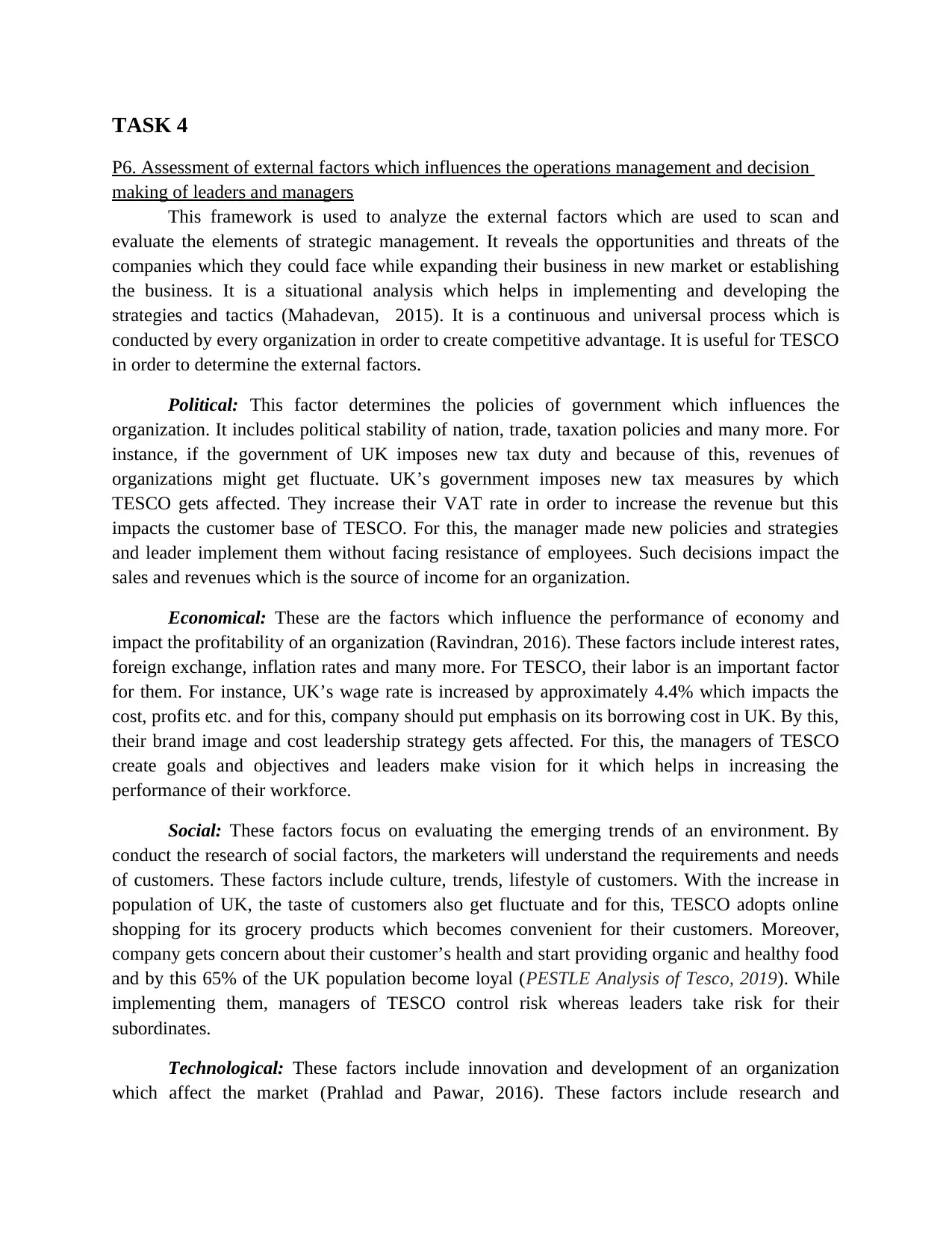
TASK 4
P6. Assessment of external factors which influences the operations management and decision
making of leaders and managers
This framework is used to analyze the external factors which are used to scan and
evaluate the elements of strategic management. It reveals the opportunities and threats of the
companies which they could face while expanding their business in new market or establishing
the business. It is a situational analysis which helps in implementing and developing the
strategies and tactics (Mahadevan, 2015). It is a continuous and universal process which is
conducted by every organization in order to create competitive advantage. It is useful for TESCO
in order to determine the external factors.
Political: This factor determines the policies of government which influences the
organization. It includes political stability of nation, trade, taxation policies and many more. For
instance, if the government of UK imposes new tax duty and because of this, revenues of
organizations might get fluctuate. UK’s government imposes new tax measures by which
TESCO gets affected. They increase their VAT rate in order to increase the revenue but this
impacts the customer base of TESCO. For this, the manager made new policies and strategies
and leader implement them without facing resistance of employees. Such decisions impact the
sales and revenues which is the source of income for an organization.
Economical: These are the factors which influence the performance of economy and
impact the profitability of an organization (Ravindran, 2016). These factors include interest rates,
foreign exchange, inflation rates and many more. For TESCO, their labor is an important factor
for them. For instance, UK’s wage rate is increased by approximately 4.4% which impacts the
cost, profits etc. and for this, company should put emphasis on its borrowing cost in UK. By this,
their brand image and cost leadership strategy gets affected. For this, the managers of TESCO
create goals and objectives and leaders make vision for it which helps in increasing the
performance of their workforce.
Social: These factors focus on evaluating the emerging trends of an environment. By
conduct the research of social factors, the marketers will understand the requirements and needs
of customers. These factors include culture, trends, lifestyle of customers. With the increase in
population of UK, the taste of customers also get fluctuate and for this, TESCO adopts online
shopping for its grocery products which becomes convenient for their customers. Moreover,
company gets concern about their customer’s health and start providing organic and healthy food
and by this 65% of the UK population become loyal (PESTLE Analysis of Tesco, 2019). While
implementing them, managers of TESCO control risk whereas leaders take risk for their
subordinates.
Technological: These factors include innovation and development of an organization
which affect the market (Prahlad and Pawar, 2016). These factors include research and
P6. Assessment of external factors which influences the operations management and decision
making of leaders and managers
This framework is used to analyze the external factors which are used to scan and
evaluate the elements of strategic management. It reveals the opportunities and threats of the
companies which they could face while expanding their business in new market or establishing
the business. It is a situational analysis which helps in implementing and developing the
strategies and tactics (Mahadevan, 2015). It is a continuous and universal process which is
conducted by every organization in order to create competitive advantage. It is useful for TESCO
in order to determine the external factors.
Political: This factor determines the policies of government which influences the
organization. It includes political stability of nation, trade, taxation policies and many more. For
instance, if the government of UK imposes new tax duty and because of this, revenues of
organizations might get fluctuate. UK’s government imposes new tax measures by which
TESCO gets affected. They increase their VAT rate in order to increase the revenue but this
impacts the customer base of TESCO. For this, the manager made new policies and strategies
and leader implement them without facing resistance of employees. Such decisions impact the
sales and revenues which is the source of income for an organization.
Economical: These are the factors which influence the performance of economy and
impact the profitability of an organization (Ravindran, 2016). These factors include interest rates,
foreign exchange, inflation rates and many more. For TESCO, their labor is an important factor
for them. For instance, UK’s wage rate is increased by approximately 4.4% which impacts the
cost, profits etc. and for this, company should put emphasis on its borrowing cost in UK. By this,
their brand image and cost leadership strategy gets affected. For this, the managers of TESCO
create goals and objectives and leaders make vision for it which helps in increasing the
performance of their workforce.
Social: These factors focus on evaluating the emerging trends of an environment. By
conduct the research of social factors, the marketers will understand the requirements and needs
of customers. These factors include culture, trends, lifestyle of customers. With the increase in
population of UK, the taste of customers also get fluctuate and for this, TESCO adopts online
shopping for its grocery products which becomes convenient for their customers. Moreover,
company gets concern about their customer’s health and start providing organic and healthy food
and by this 65% of the UK population become loyal (PESTLE Analysis of Tesco, 2019). While
implementing them, managers of TESCO control risk whereas leaders take risk for their
subordinates.
Technological: These factors include innovation and development of an organization
which affect the market (Prahlad and Pawar, 2016). These factors include research and
⊘ This is a preview!⊘
Do you want full access?
Subscribe today to unlock all pages.

Trusted by 1+ million students worldwide
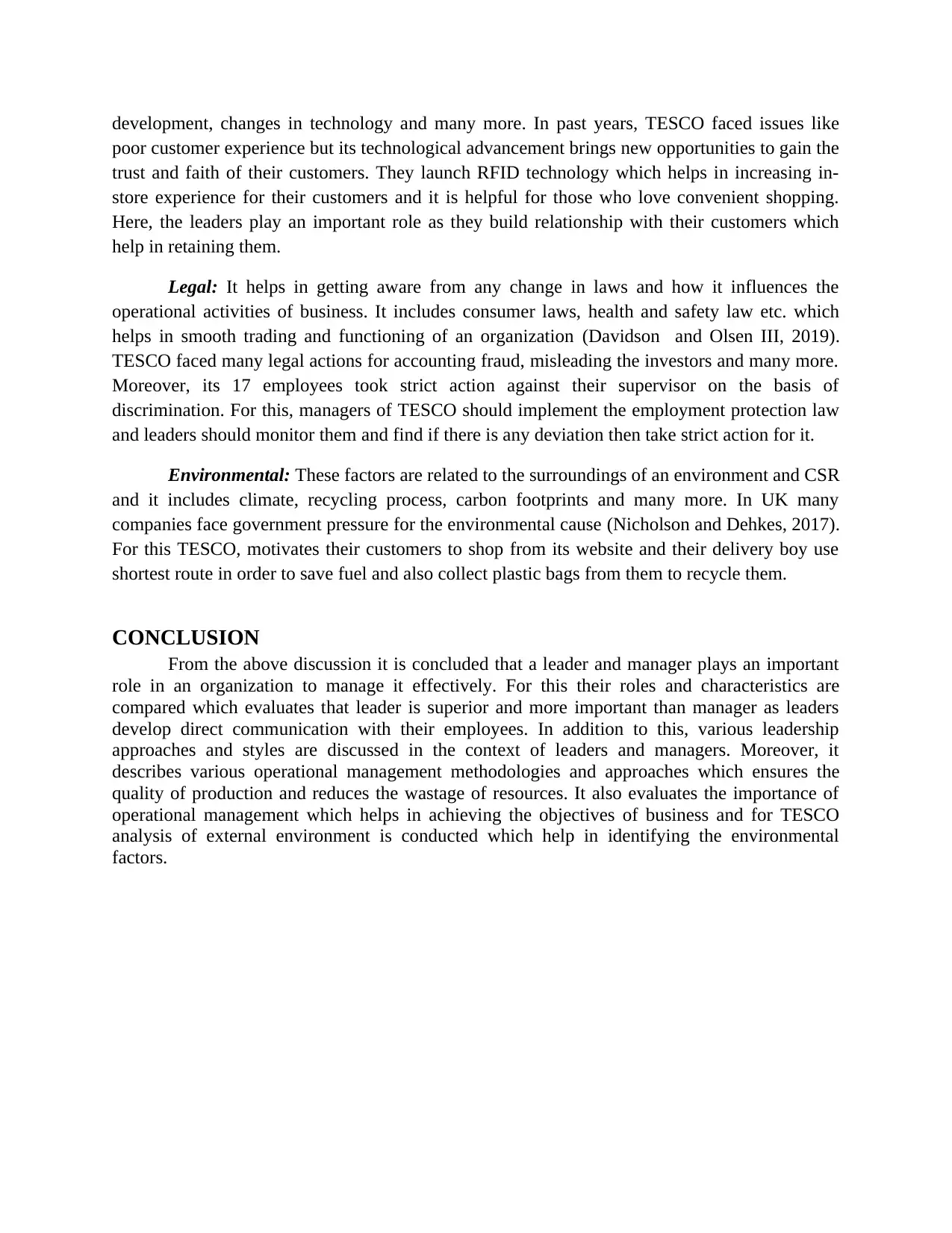
development, changes in technology and many more. In past years, TESCO faced issues like
poor customer experience but its technological advancement brings new opportunities to gain the
trust and faith of their customers. They launch RFID technology which helps in increasing in-
store experience for their customers and it is helpful for those who love convenient shopping.
Here, the leaders play an important role as they build relationship with their customers which
help in retaining them.
Legal: It helps in getting aware from any change in laws and how it influences the
operational activities of business. It includes consumer laws, health and safety law etc. which
helps in smooth trading and functioning of an organization (Davidson and Olsen III, 2019).
TESCO faced many legal actions for accounting fraud, misleading the investors and many more.
Moreover, its 17 employees took strict action against their supervisor on the basis of
discrimination. For this, managers of TESCO should implement the employment protection law
and leaders should monitor them and find if there is any deviation then take strict action for it.
Environmental: These factors are related to the surroundings of an environment and CSR
and it includes climate, recycling process, carbon footprints and many more. In UK many
companies face government pressure for the environmental cause (Nicholson and Dehkes, 2017).
For this TESCO, motivates their customers to shop from its website and their delivery boy use
shortest route in order to save fuel and also collect plastic bags from them to recycle them.
CONCLUSION
From the above discussion it is concluded that a leader and manager plays an important
role in an organization to manage it effectively. For this their roles and characteristics are
compared which evaluates that leader is superior and more important than manager as leaders
develop direct communication with their employees. In addition to this, various leadership
approaches and styles are discussed in the context of leaders and managers. Moreover, it
describes various operational management methodologies and approaches which ensures the
quality of production and reduces the wastage of resources. It also evaluates the importance of
operational management which helps in achieving the objectives of business and for TESCO
analysis of external environment is conducted which help in identifying the environmental
factors.
poor customer experience but its technological advancement brings new opportunities to gain the
trust and faith of their customers. They launch RFID technology which helps in increasing in-
store experience for their customers and it is helpful for those who love convenient shopping.
Here, the leaders play an important role as they build relationship with their customers which
help in retaining them.
Legal: It helps in getting aware from any change in laws and how it influences the
operational activities of business. It includes consumer laws, health and safety law etc. which
helps in smooth trading and functioning of an organization (Davidson and Olsen III, 2019).
TESCO faced many legal actions for accounting fraud, misleading the investors and many more.
Moreover, its 17 employees took strict action against their supervisor on the basis of
discrimination. For this, managers of TESCO should implement the employment protection law
and leaders should monitor them and find if there is any deviation then take strict action for it.
Environmental: These factors are related to the surroundings of an environment and CSR
and it includes climate, recycling process, carbon footprints and many more. In UK many
companies face government pressure for the environmental cause (Nicholson and Dehkes, 2017).
For this TESCO, motivates their customers to shop from its website and their delivery boy use
shortest route in order to save fuel and also collect plastic bags from them to recycle them.
CONCLUSION
From the above discussion it is concluded that a leader and manager plays an important
role in an organization to manage it effectively. For this their roles and characteristics are
compared which evaluates that leader is superior and more important than manager as leaders
develop direct communication with their employees. In addition to this, various leadership
approaches and styles are discussed in the context of leaders and managers. Moreover, it
describes various operational management methodologies and approaches which ensures the
quality of production and reduces the wastage of resources. It also evaluates the importance of
operational management which helps in achieving the objectives of business and for TESCO
analysis of external environment is conducted which help in identifying the environmental
factors.
Paraphrase This Document
Need a fresh take? Get an instant paraphrase of this document with our AI Paraphraser
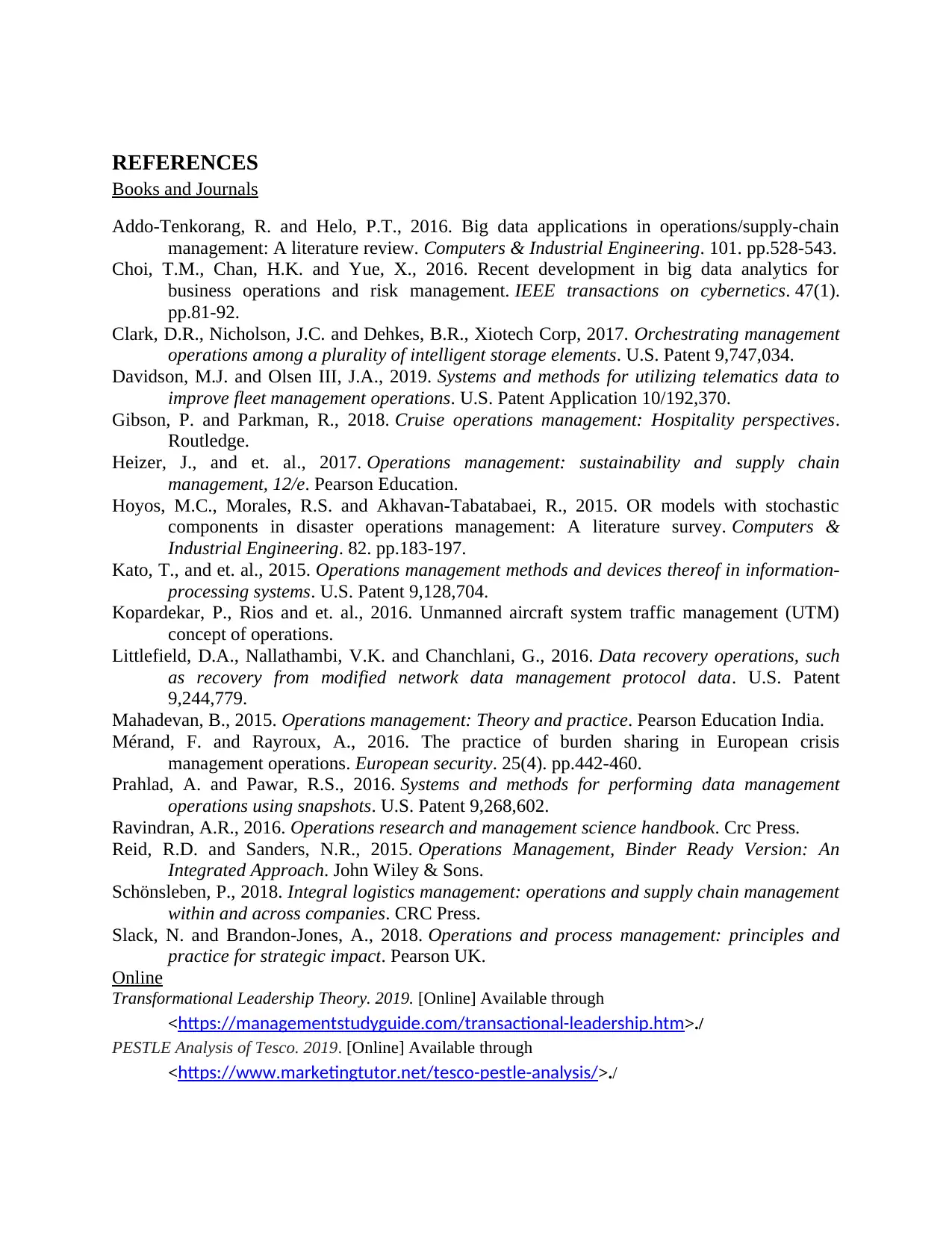
REFERENCES
Books and Journals
Addo-Tenkorang, R. and Helo, P.T., 2016. Big data applications in operations/supply-chain
management: A literature review. Computers & Industrial Engineering. 101. pp.528-543.
Choi, T.M., Chan, H.K. and Yue, X., 2016. Recent development in big data analytics for
business operations and risk management. IEEE transactions on cybernetics. 47(1).
pp.81-92.
Clark, D.R., Nicholson, J.C. and Dehkes, B.R., Xiotech Corp, 2017. Orchestrating management
operations among a plurality of intelligent storage elements. U.S. Patent 9,747,034.
Davidson, M.J. and Olsen III, J.A., 2019. Systems and methods for utilizing telematics data to
improve fleet management operations. U.S. Patent Application 10/192,370.
Gibson, P. and Parkman, R., 2018. Cruise operations management: Hospitality perspectives.
Routledge.
Heizer, J., and et. al., 2017. Operations management: sustainability and supply chain
management, 12/e. Pearson Education.
Hoyos, M.C., Morales, R.S. and Akhavan-Tabatabaei, R., 2015. OR models with stochastic
components in disaster operations management: A literature survey. Computers &
Industrial Engineering. 82. pp.183-197.
Kato, T., and et. al., 2015. Operations management methods and devices thereof in information-
processing systems. U.S. Patent 9,128,704.
Kopardekar, P., Rios and et. al., 2016. Unmanned aircraft system traffic management (UTM)
concept of operations.
Littlefield, D.A., Nallathambi, V.K. and Chanchlani, G., 2016. Data recovery operations, such
as recovery from modified network data management protocol data. U.S. Patent
9,244,779.
Mahadevan, B., 2015. Operations management: Theory and practice. Pearson Education India.
Mérand, F. and Rayroux, A., 2016. The practice of burden sharing in European crisis
management operations. European security. 25(4). pp.442-460.
Prahlad, A. and Pawar, R.S., 2016. Systems and methods for performing data management
operations using snapshots. U.S. Patent 9,268,602.
Ravindran, A.R., 2016. Operations research and management science handbook. Crc Press.
Reid, R.D. and Sanders, N.R., 2015. Operations Management, Binder Ready Version: An
Integrated Approach. John Wiley & Sons.
Schönsleben, P., 2018. Integral logistics management: operations and supply chain management
within and across companies. CRC Press.
Slack, N. and Brandon-Jones, A., 2018. Operations and process management: principles and
practice for strategic impact. Pearson UK.
Online
Transformational Leadership Theory. 2019. [Online] Available through
<https://managementstudyguide.com/transactional-leadership.htm>./
PESTLE Analysis of Tesco. 2019. [Online] Available through
<https://www.marketingtutor.net/tesco-pestle-analysis/>./
Books and Journals
Addo-Tenkorang, R. and Helo, P.T., 2016. Big data applications in operations/supply-chain
management: A literature review. Computers & Industrial Engineering. 101. pp.528-543.
Choi, T.M., Chan, H.K. and Yue, X., 2016. Recent development in big data analytics for
business operations and risk management. IEEE transactions on cybernetics. 47(1).
pp.81-92.
Clark, D.R., Nicholson, J.C. and Dehkes, B.R., Xiotech Corp, 2017. Orchestrating management
operations among a plurality of intelligent storage elements. U.S. Patent 9,747,034.
Davidson, M.J. and Olsen III, J.A., 2019. Systems and methods for utilizing telematics data to
improve fleet management operations. U.S. Patent Application 10/192,370.
Gibson, P. and Parkman, R., 2018. Cruise operations management: Hospitality perspectives.
Routledge.
Heizer, J., and et. al., 2017. Operations management: sustainability and supply chain
management, 12/e. Pearson Education.
Hoyos, M.C., Morales, R.S. and Akhavan-Tabatabaei, R., 2015. OR models with stochastic
components in disaster operations management: A literature survey. Computers &
Industrial Engineering. 82. pp.183-197.
Kato, T., and et. al., 2015. Operations management methods and devices thereof in information-
processing systems. U.S. Patent 9,128,704.
Kopardekar, P., Rios and et. al., 2016. Unmanned aircraft system traffic management (UTM)
concept of operations.
Littlefield, D.A., Nallathambi, V.K. and Chanchlani, G., 2016. Data recovery operations, such
as recovery from modified network data management protocol data. U.S. Patent
9,244,779.
Mahadevan, B., 2015. Operations management: Theory and practice. Pearson Education India.
Mérand, F. and Rayroux, A., 2016. The practice of burden sharing in European crisis
management operations. European security. 25(4). pp.442-460.
Prahlad, A. and Pawar, R.S., 2016. Systems and methods for performing data management
operations using snapshots. U.S. Patent 9,268,602.
Ravindran, A.R., 2016. Operations research and management science handbook. Crc Press.
Reid, R.D. and Sanders, N.R., 2015. Operations Management, Binder Ready Version: An
Integrated Approach. John Wiley & Sons.
Schönsleben, P., 2018. Integral logistics management: operations and supply chain management
within and across companies. CRC Press.
Slack, N. and Brandon-Jones, A., 2018. Operations and process management: principles and
practice for strategic impact. Pearson UK.
Online
Transformational Leadership Theory. 2019. [Online] Available through
<https://managementstudyguide.com/transactional-leadership.htm>./
PESTLE Analysis of Tesco. 2019. [Online] Available through
<https://www.marketingtutor.net/tesco-pestle-analysis/>./
1 out of 11
Related Documents
Your All-in-One AI-Powered Toolkit for Academic Success.
+13062052269
info@desklib.com
Available 24*7 on WhatsApp / Email
![[object Object]](/_next/static/media/star-bottom.7253800d.svg)
Unlock your academic potential
Copyright © 2020–2025 A2Z Services. All Rights Reserved. Developed and managed by ZUCOL.





